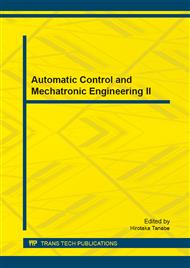p.502
p.506
p.510
p.515
p.519
p.524
p.529
p.534
p.538
Modeling and Workplace Analysis of 3T Cable-Driven Parallel Manipulator
Abstract:
This paper analyzes the dynamic modeling and workplace of the 3T cable-driven parallel manipulator. The mechanism utilizes four cables to driven. Firstly, the kinematics equations and the inverse dynamics model were set up for the analysis. And then, pseudo-drag is a serious problem in cable-driven parallel manipulator, this paper give a method to find the workplace under the condition of pseudo-drag. Finally, through numerical simulation, the workplace of the mechanism satisfying the demand is presented by comprehensive analysis.
Info:
Periodical:
Pages:
519-523
Citation:
Online since:
September 2013
Authors:
Price:
Сopyright:
© 2013 Trans Tech Publications Ltd. All Rights Reserved
Share:
Citation:


